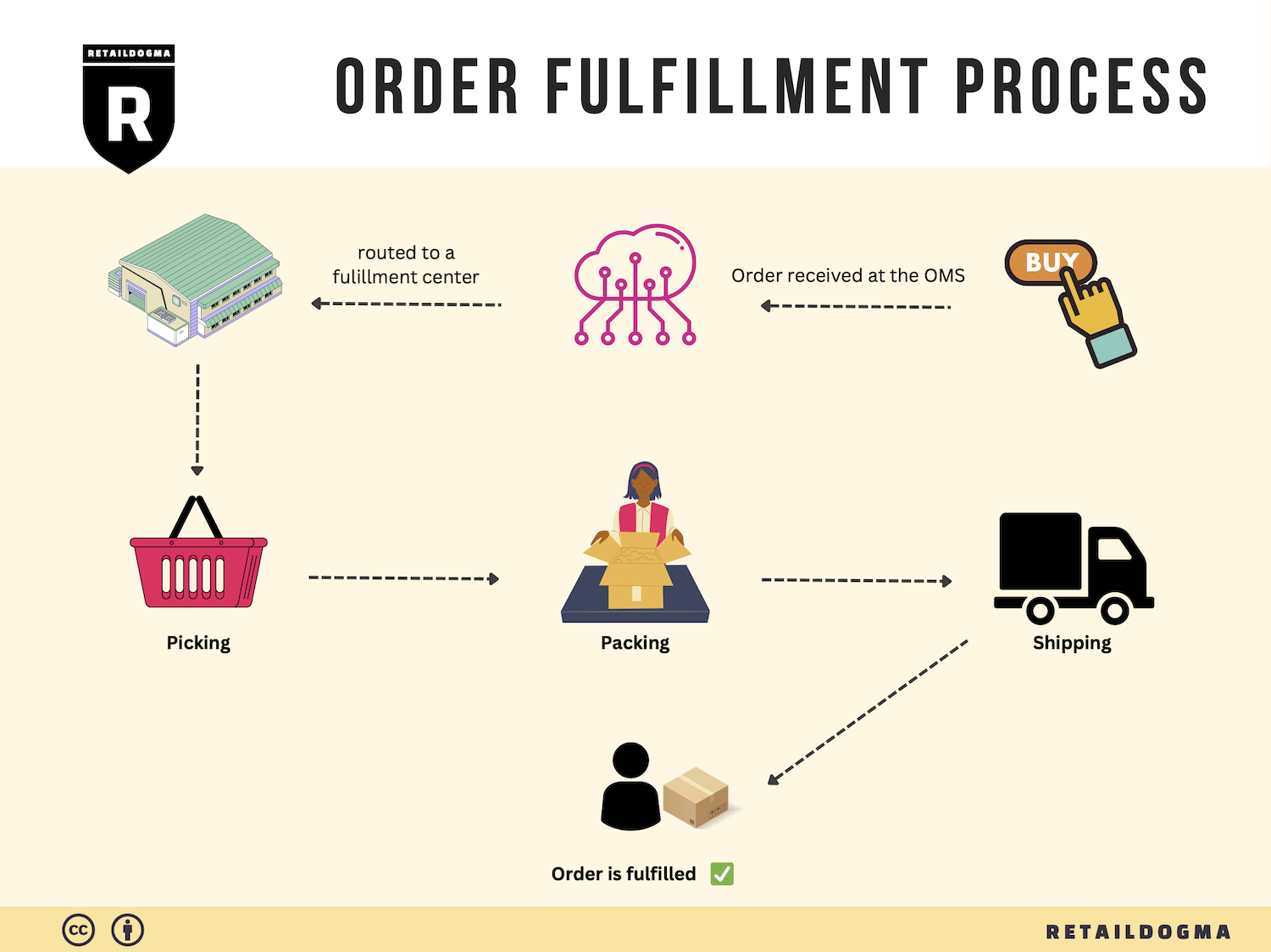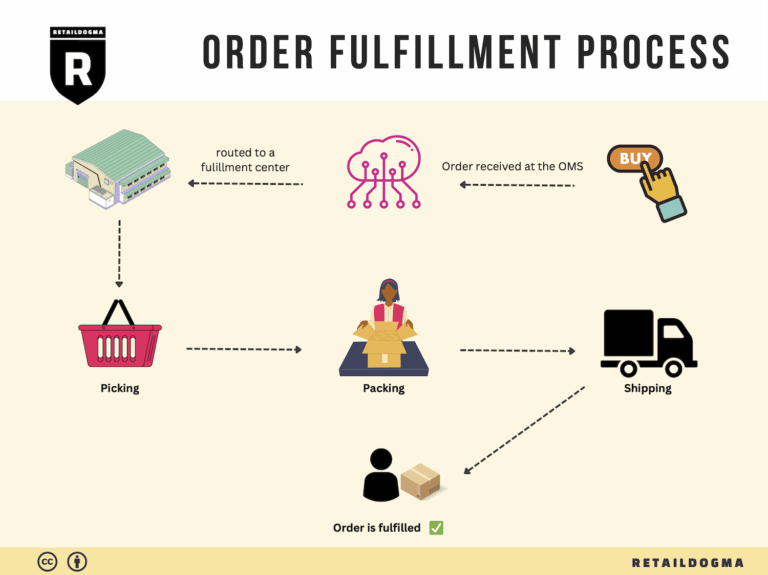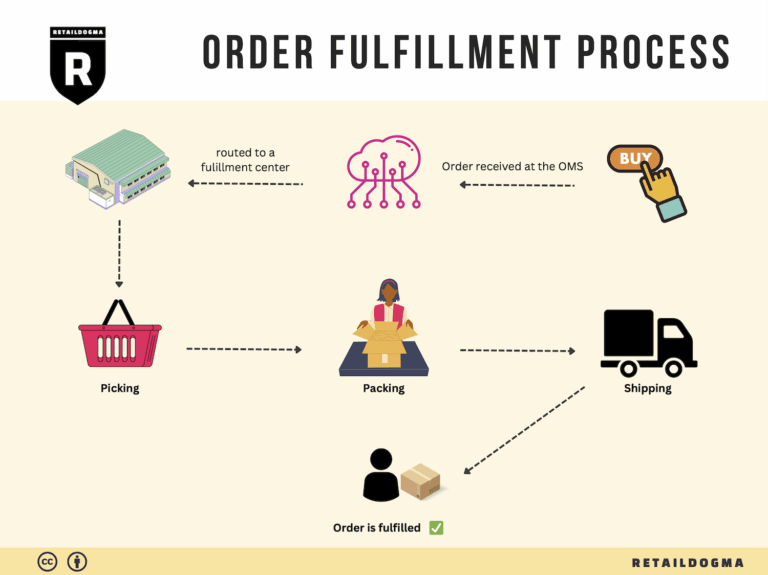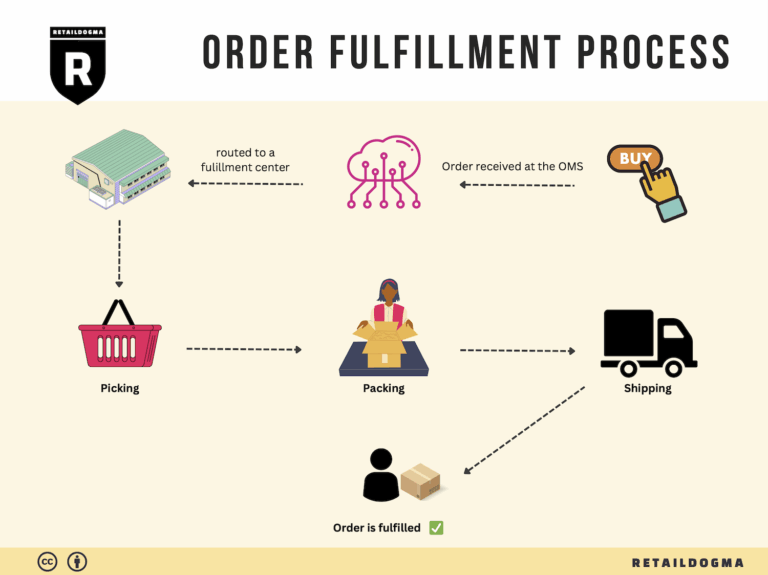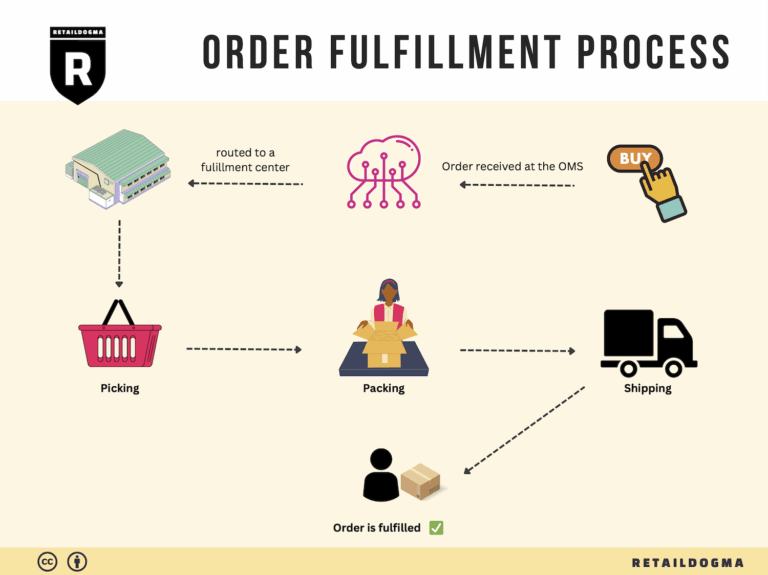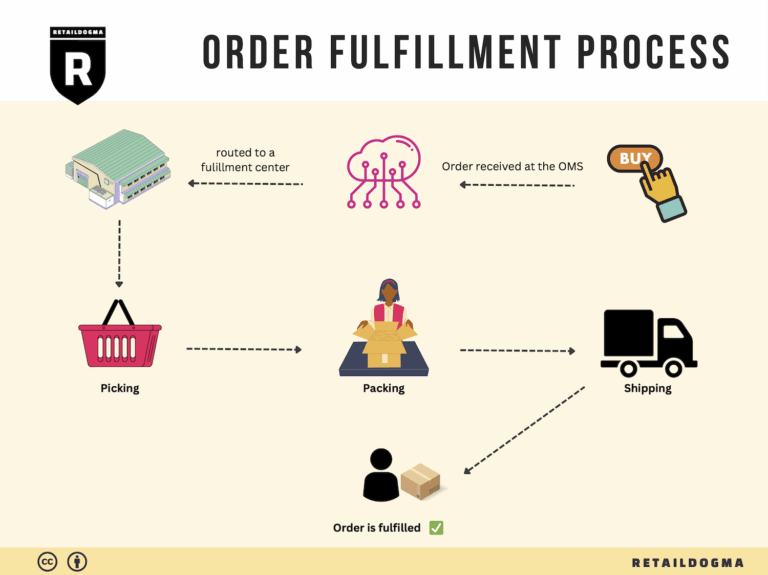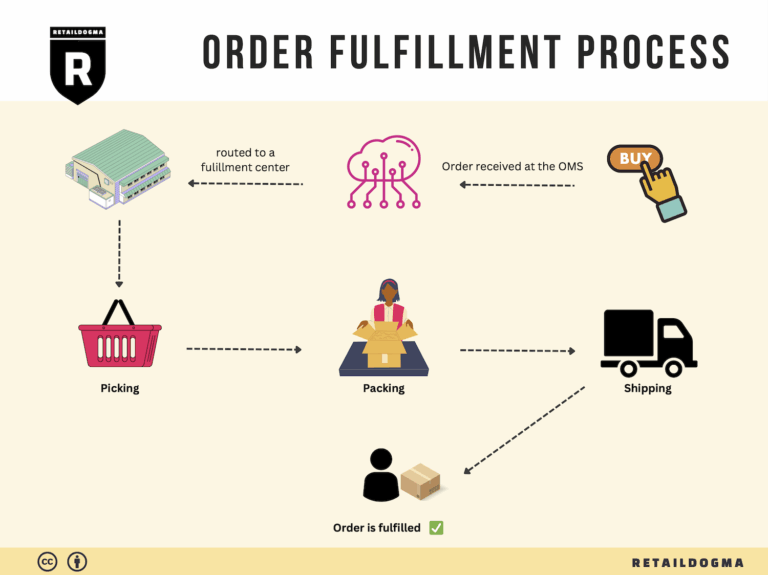What Is A Fulfillment Center? A Complete Guide (2025)
What is E-commerce Fulfillment? An Introduction for Growing Businesses
Understanding E-commerce Fulfillment
For many growing e-commerce businesses, the excitement of increased sales often comes with the daunting challenge of managing order fulfillment. As your sales volume rises, so too does the complexity of packing and shipping orders. This can lead to overwhelm, especially when you’re trying to maintain a high level of customer satisfaction while managing your inventory and logistics. The fulfillment process—essentially the method of getting products from your warehouse to your customers—is a critical component of your operations that can make or break your business.
E-commerce fulfillment involves several key steps: receiving inventory, storing it properly, processing orders, packing items securely, and shipping them to customers. It’s not just about sending products; it’s about creating a seamless experience that keeps customers coming back. As you scale, understanding the various fulfillment models available—such as third-party logistics (3PL) and Fulfillment by Amazon (FBA)—becomes essential.
This guide aims to demystify the world of e-commerce fulfillment by exploring the different models and their respective advantages and disadvantages. You will learn about core services that fulfillment partners provide, including inventory management, order processing, and shipping logistics. Understanding these services can help you determine what level of support you need as you grow.
Choosing the right fulfillment partner is another crucial aspect we will cover. The right partner can not only alleviate the burden of logistics but also offer strategic insights that can enhance your operational efficiency. Factors to consider include their technology capabilities, customer service, scalability, and pricing structures.
Lastly, we will delve into pricing—an often-overlooked element in fulfillment decisions. Understanding the costs associated with different fulfillment strategies will empower you to make informed choices that align with your budget and growth objectives.
Our goal with this guide is to equip e-commerce business owners, operations managers, and entrepreneurs with the knowledge they need to make strategic decisions about their logistics. By understanding the intricacies of e-commerce fulfillment, you can create a streamlined process that not only meets customer expectations but also supports your business’s growth trajectory. Let’s dive in and explore the world of e-commerce fulfillment together.
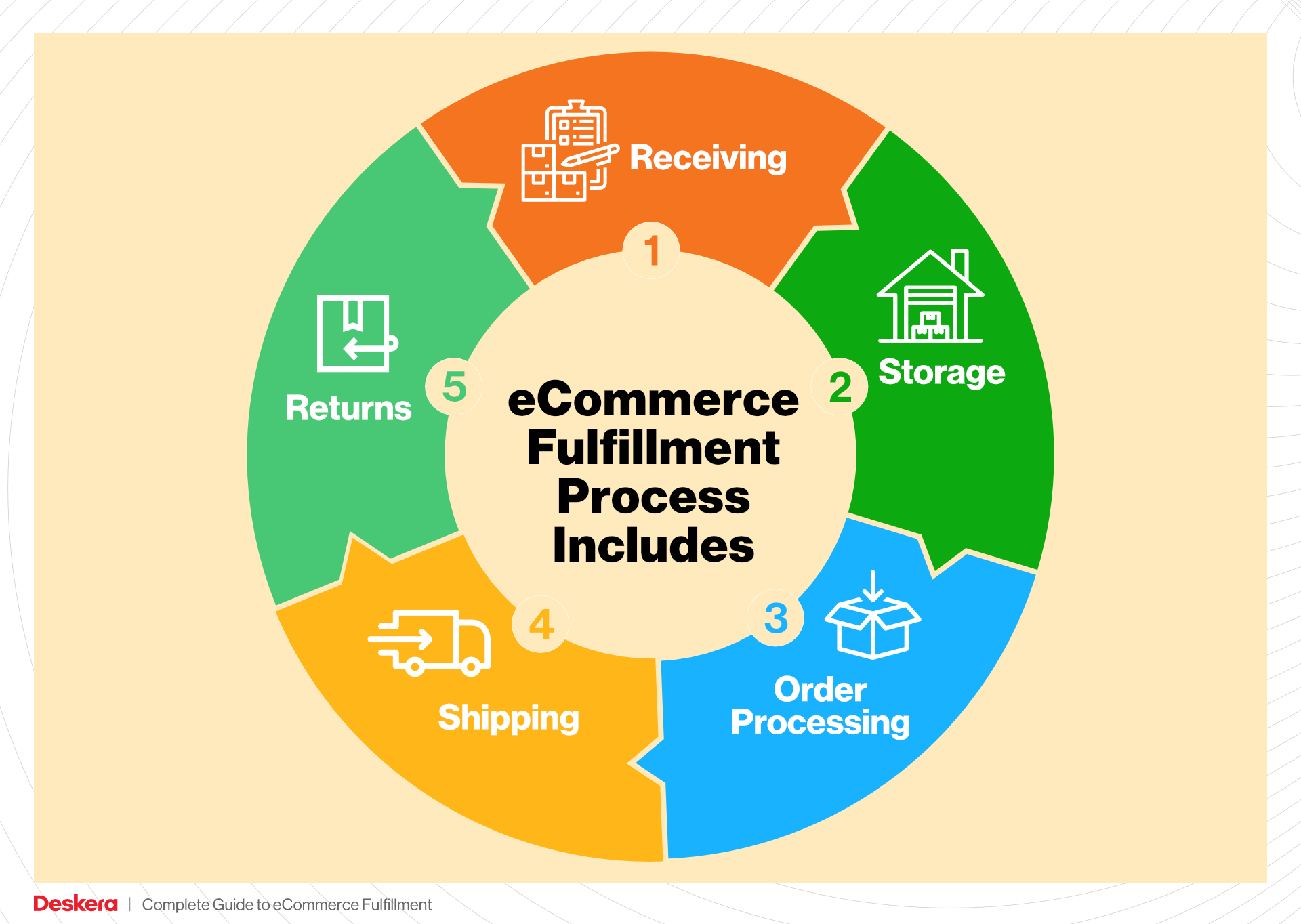
What You’ll Learn In This Guide
- What is E-commerce Fulfillment? An Introduction for Growing Businesses
- The Order Fulfillment Process: From ‘Buy’ Button to Customer’s Door
- Comparing Fulfillment Models: In-House vs. 3PL vs. Dropshipping
- A Deep Dive into Amazon FBA: Pros, Cons, and Who It’s For
- Core Services Offered by Fulfillment Centers
- How to Choose a Fulfillment Partner: A 6-Point Checklist
- Understanding Fulfillment Pricing: A Breakdown of Common Fees
- Frequently Asked Questions (FAQs) about Fulfillment
- Conclusion: Is Outsourcing Fulfillment the Right Move for Your Business?
- Important Disclaimer
The Order Fulfillment Process: From ‘Buy’ Button to Customer’s Door
1. Receiving Inventory
The order fulfillment process begins with receiving inventory. This step involves the acceptance of products from suppliers and manufacturers into your warehouse or fulfillment center. Upon arrival, each shipment should be checked against purchase orders to ensure accuracy in quantity and quality. This is where the term SKU (Stock Keeping Unit) comes into play, as it is essential for tracking individual items.
Proper inventory receiving is critical because it sets the foundation for all subsequent steps. Any discrepancies at this stage can lead to stockouts or overstock situations, directly impacting customer satisfaction and profitability. Implementing a robust receiving process helps maintain accurate inventory levels, ensuring that your business can meet demand without over-investing in stock.
2. Warehouse Storage
Once the inventory has been received and verified, the next step is warehouse storage. This involves organizing and storing the products in a way that maximizes space and facilitates easy access. Efficient warehouse storage strategies often utilize bin locations or shelf labeling to ensure that items are easily found and retrieved.
The importance of this step cannot be overstated; effective warehouse storage reduces retrieval times and minimizes the risk of errors when fulfilling orders. By implementing systematic storage solutions, you can increase the overall efficiency of your operations, making it easier to locate items and reduce the time it takes to process orders. This is especially vital as your business scales, requiring more sophisticated inventory management.
3. Order Picking
Order picking is the process of retrieving items from inventory to fulfill customer orders. This step typically utilizes pick lists, which are generated based on incoming orders and indicate the specific items and quantities that need to be collected. There are various picking methods, such as single order picking, batch picking, and zone picking, each suited to different operational needs.
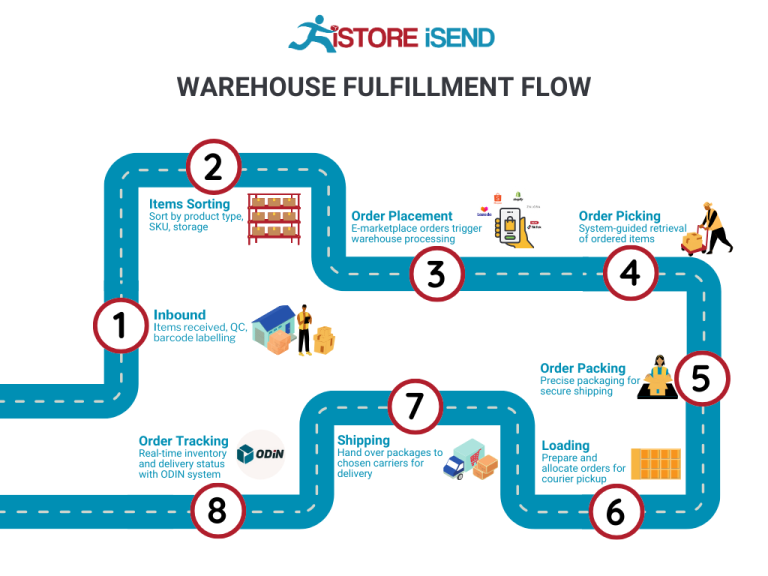
This step is crucial because the accuracy of order picking directly affects customer satisfaction. Errors in this phase can lead to incorrect shipments, resulting in returns and damage to your brand reputation. By investing in technology like barcode scanners or automated picking systems, businesses can enhance accuracy and efficiency, ensuring that customers receive the right products on time.
4. Order Packing
After items have been picked, they move to the packing stage. Here, products are carefully packed into boxes or envelopes, ensuring they are secure for shipping. Key considerations during packing include using the right packaging materials and including any necessary documentation, such as invoices or return slips.
The significance of this step lies in its impact on customer experience. A well-packed order not only protects the products during transit but also enhances the unboxing experience for the customer. Utilizing branded packaging can also serve as a marketing opportunity, reinforcing brand identity. Additionally, efficient packing can optimize shipping costs by minimizing dimensional weight, which is particularly important as businesses scale and shipping volumes increase.
5. Shipping & Delivery
The final step in the order fulfillment process is shipping and delivery. This involves selecting the appropriate carrier, generating shipping labels, and scheduling pickups or drop-offs. Key terms associated with this step include shipping methods (e.g., standard, expedited) and tracking numbers, which allow customers to monitor their shipments.
This step is pivotal as it ultimately determines how quickly and reliably customers receive their orders. A streamlined shipping process can enhance customer satisfaction, leading to repeat business and positive reviews. As you scale your operations, consider partnerships with multiple carriers to offer a range of shipping options and optimize delivery times and costs. Implementing real-time tracking systems can further enhance transparency and trust with your customers.
By understanding and optimizing each step of the order fulfillment process, e-commerce businesses can significantly improve operational efficiency, reduce errors, and enhance customer satisfaction. Investing in technology and best practices at each stage will support your growth ambitions and create a seamless experience from the moment a customer clicks the ‘Buy’ button to when their order arrives at their door.
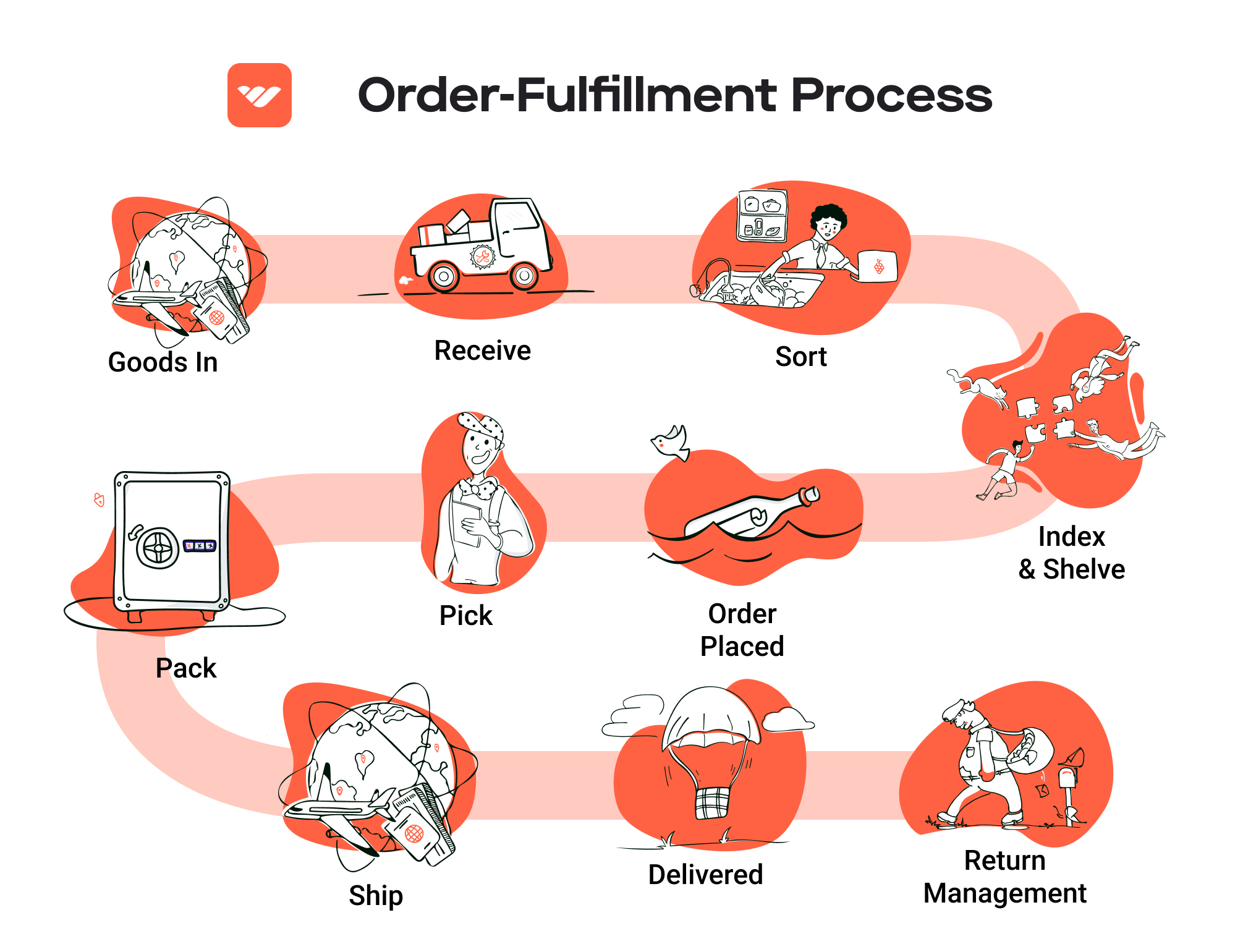
Comparing Fulfillment Models: In-House vs. 3PL vs. Dropshipping
Comparison of Fulfillment Models
| Model | Who Handles Inventory | Best For (Business Stage) | Key Advantage | Key Disadvantage |
|---|---|---|---|---|
| In-House Fulfillment | The business itself | Established businesses | Full control over inventory and processes | High overhead costs and resource demands |
| Third-Party Logistics (3PL) | A third-party provider | Growing businesses | Scalability and expertise in logistics | Less control over inventory and processes |
| Dropshipping | Supplier or manufacturer | Startups and small businesses | Low startup costs and minimal risk | Lower profit margins and reliance on suppliers |
In-House Fulfillment
In-house fulfillment involves managing the entire logistics process within the business itself. This model is often adopted by established companies that have the resources to handle their inventory, order processing, and shipping. The key advantage of in-house fulfillment is that it provides complete control over the entire supply chain, allowing businesses to manage inventory levels, fulfillment speed, and quality assurance directly. This can lead to improved customer satisfaction, as businesses can tailor their processes to meet specific customer needs.
However, the in-house model comes with significant challenges. It requires substantial investments in warehouse space, technology, and human resources, which can lead to high overhead costs. Additionally, managing logistics can divert attention from core business activities, especially for smaller companies or startups. As a business scales, the complexities of in-house fulfillment can also increase, making it difficult to maintain efficiency without significant investment.
Third-Party Logistics (3PL)
Third-party logistics (3PL) providers offer outsourced logistics services, handling everything from warehousing to shipping for businesses. This model is particularly beneficial for growing businesses that want to scale their operations without the burden of managing logistics themselves. By partnering with a 3PL provider, businesses can leverage the provider’s expertise, technology, and established networks to streamline their fulfillment processes.
The key advantage of using a 3PL is the scalability it offers. As order volumes increase, businesses can adjust their logistics needs without the need for heavy investments in infrastructure. Additionally, 3PL providers often have advanced technology and logistics systems that can enhance efficiency and reduce shipping times. However, the downside is that businesses may experience less control over their inventory and fulfillment processes, which can lead to inconsistencies in service quality. Moreover, choosing the wrong 3PL partner can lead to operational challenges and customer dissatisfaction if not properly managed.
Dropshipping
Dropshipping is a fulfillment model where the retailer does not hold inventory but instead relies on suppliers to fulfill orders directly to customers. This model is ideal for startups and small businesses looking to minimize upfront costs and reduce financial risk. Since retailers don’t have to invest in inventory, they can focus on marketing and sales, making it easier to enter the market with a broader product range.
The primary advantage of dropshipping is the low barrier to entry. Retailers can start selling products without the need for significant capital investment in inventory, making it a popular choice for new entrepreneurs. However, dropshipping comes with its own set of challenges. Profit margins are typically lower compared to other fulfillment models, as retailers often have to pay a premium for the convenience of not holding inventory. Additionally, retailers are reliant on their suppliers for product quality and shipping times, which can lead to customer dissatisfaction if issues arise. Managing relationships with multiple suppliers can also complicate operations, particularly as the business scales.
Conclusion
Choosing the right fulfillment model is critical for e-commerce businesses, especially when scaling operations. Each model—In-House Fulfillment, 3PL, and Dropshipping—has its unique set of advantages and disadvantages that must be carefully weighed against the business’s specific needs, resources, and growth stage. By understanding these differences, business owners can make informed decisions that align with their operational goals and customer expectations.
A Deep Dive into Amazon FBA: Pros, Cons, and Who It’s For
Understanding Fulfillment by Amazon (FBA)
Fulfillment by Amazon (FBA) is a service provided by Amazon that allows e-commerce sellers to store their products in Amazon’s fulfillment centers. Amazon takes care of storage, packaging, shipping, and customer service, allowing sellers to focus on growing their businesses. When a customer orders a product, Amazon picks, packs, and ships it on behalf of the seller. This service not only simplifies logistics but also provides sellers with access to Amazon’s extensive customer base.
How FBA Works
-
Product Setup: Sellers create product listings on Amazon and choose FBA as their fulfillment method. They must prepare their products according to Amazon’s guidelines.
-
Inventory Shipment: Sellers send their inventory to Amazon’s fulfillment centers. Amazon provides specific shipping labels and instructions for this process.
-
Storage: Once received, products are stored in Amazon’s warehouses. Sellers can monitor their inventory levels through Amazon’s Seller Central dashboard.
-
Order Processing: When a customer places an order, Amazon handles the entire fulfillment process. This includes picking the product from the shelf, packing it, and shipping it directly to the customer.
-
Customer Service: Amazon also manages customer inquiries and returns, providing a seamless experience for both sellers and buyers.
-
Reporting and Analytics: Sellers have access to detailed reporting and analytics, allowing them to track sales, inventory levels, and customer feedback.
Pros of Using FBA
Prime Eligibility
One of the most significant advantages of FBA is that it makes products eligible for Amazon Prime. This status can significantly increase sales, as Prime members often prefer items that qualify for free two-day shipping. This can lead to higher conversion rates and increased visibility in search results.
Customer Trust
Products fulfilled by Amazon benefit from the trust associated with the Amazon brand. Customers are more likely to purchase items that are fulfilled by Amazon due to the perceived reliability in shipping and customer service. This trust can lead to increased sales and positive reviews.
Multi-Channel Fulfillment
FBA is not limited to Amazon sales alone. Sellers can use FBA to fulfill orders from other sales channels, such as their own websites or other online marketplaces. This flexibility allows sellers to streamline their operations and manage inventory from a single source.
Simplified Logistics
FBA takes the burden of logistics off sellers’ shoulders. Amazon handles everything from storage to shipping, which can save time and resources. This allows sellers to focus more on marketing, product development, and scaling their businesses.
Scalability
As businesses grow, so do their logistics challenges. FBA provides a scalable solution that can adapt to increased order volumes without requiring sellers to invest in warehousing or fulfillment infrastructure.
Cons of Using FBA
High Fees
FBA comes with various fees that can impact a seller’s profit margins. These fees include storage fees for keeping inventory in Amazon’s warehouses and fulfillment fees for picking, packing, and shipping items. Sellers must carefully calculate these costs to ensure profitability.
Strict Inventory Rules
Amazon enforces strict inventory management rules that sellers must adhere to. This includes limitations on the number of units that can be sent to fulfillment centers, restrictions on certain product categories, and guidelines for product preparation and labeling. Non-compliance can lead to penalties or even suspension of selling privileges.
Commingling Risks
FBA allows for commingling inventory, meaning that products from multiple sellers can be stored together. While this can streamline operations, it also poses risks. If a customer receives a defective or damaged product from another seller, it can lead to negative reviews for the original seller, impacting their reputation.
Limited Control Over Fulfillment
Sellers relinquish control over the fulfillment process when they use FBA. This means they cannot manage packing or shipping directly, which can lead to inconsistencies in how their products are presented to customers. Additionally, sellers have limited ability to customize packaging or include promotional materials.
Inventory Mismanagement
Due to the high volume of items processed through FBA, inventory mismanagement can occur. Sellers may experience issues with lost inventory or discrepancies between reported stock levels and actual counts. Resolving these issues can be time-consuming and frustrating.
Who is FBA Best For?
Fulfillment by Amazon is best suited for e-commerce businesses that:
-
Sell High-Volume Products: Businesses with a steady stream of orders can benefit from FBA’s scalability and efficiency, allowing them to manage larger inventories without overwhelming their logistics.
-
Desire to Tap into Amazon’s Customer Base: Sellers looking to leverage Amazon’s vast customer reach and brand trust can significantly increase their sales by utilizing FBA.
-
Want to Simplify Logistics: Entrepreneurs and small business owners who prefer to focus on marketing and product development rather than logistics will find FBA a valuable asset.
-
Operate Multiple Sales Channels: Brands that sell on various platforms and want a unified fulfillment solution can take advantage of FBA’s multi-channel fulfillment capabilities.
-
Are Prepared for Fees: Sellers who understand the fee structure and are confident that their profit margins can accommodate these costs are well-positioned to succeed with FBA.
In conclusion, while FBA presents numerous advantages, it is crucial for sellers to weigh these against the potential drawbacks. By understanding how FBA works and who it best serves, businesses can make informed decisions about whether to incorporate this fulfillment method into their operations.
Core Services Offered by Fulfillment Centers
Inventory Management & Warehousing
Inventory management and warehousing are foundational services provided by fulfillment centers, crucial for e-commerce businesses aiming to scale efficiently. This service encompasses the storage, organization, and tracking of products to ensure that inventory levels are optimal and readily available when needed.
What It Is:
Fulfillment centers utilize advanced inventory management systems to monitor stock levels in real-time, allowing businesses to maintain accurate records of their products. These systems often integrate with e-commerce platforms, providing seamless updates on inventory counts, order statuses, and reordering needs.
Benefits:
1. Reduced Costs: By optimizing inventory levels, businesses can minimize holding costs and avoid overstock situations that tie up capital.
2. Improved Efficiency: Automated inventory tracking reduces the likelihood of human error and streamlines the order fulfillment process, leading to faster delivery times.
3. Enhanced Customer Satisfaction: With accurate inventory management, businesses can provide reliable shipping timelines and avoid stockouts, thereby improving customer trust and loyalty.
Pick and Pack Services
Pick and pack services are essential components of the fulfillment process, where products are selected from inventory and packed for shipment to customers.
What It Is:
In this service, fulfillment center staff “pick” items from the warehouse shelves according to the orders received, and then “pack” them securely for shipping. This process may involve various packaging options to ensure items are protected during transit.
Benefits:
1. Time Savings: Outsourcing pick and pack operations allows e-commerce businesses to focus on core activities such as marketing and customer service, rather than logistics.
2. Scalability: As sales volumes increase, fulfillment centers can quickly scale operations to accommodate higher order quantities without the need for additional staff or resources from the business.
3. Quality Control: Professional fulfillment centers typically have established quality control measures to ensure that the correct items are picked and packed, reducing the incidence of returns due to errors.
Kitting and Assembly
Kitting and assembly services are particularly beneficial for e-commerce businesses that offer products requiring assembly or combination before shipping.
What It Is:
Kitting involves grouping multiple products into a single kit or package, which may include assembling components into a final product. This is common in industries such as electronics, toys, and health and beauty, where customers expect complete sets or kits.
Benefits:
1. Streamlined Operations: By having a fulfillment center manage kitting and assembly, businesses can reduce the complexity of their own operations and enhance efficiency.
2. Increased Sales Opportunities: Offering bundled products can encourage upselling and cross-selling, thus increasing the average order value.
3. Customer Convenience: Delivering pre-assembled kits simplifies the purchasing process for customers, improving their overall shopping experience and satisfaction.
Returns Management (Reverse Logistics)
Returns management, or reverse logistics, is a critical service that helps e-commerce businesses handle product returns efficiently and effectively.
What It Is:
This service involves processing returned products, assessing their condition, and determining the appropriate next steps—whether that’s restocking, refurbishing, or disposal. A well-structured returns process is vital for maintaining customer satisfaction and brand reputation.
Benefits:
1. Enhanced Customer Experience: A smooth returns process can significantly improve customer satisfaction. Quick processing of returns and refunds builds trust and encourages repeat business.
2. Cost Management: Effective returns management allows businesses to recapture value from returned items, whether through resale or refurbishment, minimizing losses associated with returns.
3. Data Insights: Analyzing return data can provide valuable insights into customer behavior, product quality, and potential areas for improvement, helping businesses refine their offerings and marketing strategies.
In conclusion, partnering with a fulfillment center that offers robust core services—including inventory management, pick and pack, kitting and assembly, and returns management—can empower e-commerce businesses to streamline their operations, enhance customer satisfaction, and ultimately drive growth. By outsourcing these logistics functions, business owners can focus on strategic initiatives that promote their brand and increase sales.
How to Choose a Fulfillment Partner: A 6-Point Checklist
Location & Warehouse Network
Importance: The geographic location of your fulfillment partner is critical for efficient shipping and delivery. A partner with strategically placed warehouses can reduce shipping times and costs, which is essential for maintaining customer satisfaction and competitive pricing.
Questions to Ask:
– Where are your warehouses located, and how does that impact shipping times to my primary customer bases?
– Do you have a network of warehouses that can accommodate regional distribution?
– What is your average shipping time from your warehouses to various locations?
Technology & Integrations
Importance: A fulfillment partner’s technology stack can significantly influence your operational efficiency. Integrated systems allow for seamless data exchange between your e-commerce platform and the fulfillment partner, improving order processing speed and accuracy.
Questions to Ask:
– What e-commerce platforms do you integrate with, and how do you handle data synchronization?
– Can you provide real-time inventory tracking and reporting?
– What technology do you use for order processing, and how does it ensure accuracy and efficiency?
Specializations (e.g., Cold Storage, Oversized Items)
Importance: Depending on your product range, specific capabilities may be necessary for effective fulfillment. For example, if you sell perishable goods, your partner must have cold storage options. Similarly, if you deal in oversized items, your partner should have the necessary infrastructure.
Questions to Ask:
– Do you have specialized facilities for the storage and handling of my product type (e.g., temperature-controlled, oversized)?
– What experience do you have in managing the logistics of specialized items?
– How do you ensure compliance with regulations related to my product type?
Scalability & Capacity
Importance: As your business grows, your fulfillment needs will evolve. A suitable partner should be able to scale operations quickly and efficiently to accommodate increased order volumes without sacrificing service quality.
Questions to Ask:
– How do you handle seasonal peaks or unexpected surges in order volume?
– What is your current capacity, and how quickly can you scale up if needed?
– Can you provide examples of how you have managed increased demand for other clients?
Pricing and Contracts
Importance: Understanding the pricing structure and contractual obligations is vital to ensure that your fulfillment costs align with your budget and business model. Transparent pricing helps avoid unexpected fees that can impact your margins.
Questions to Ask:
– What is your pricing model (e.g., per order, per item, monthly fees)?
– Are there any additional fees (e.g., for storage, packaging, or special handling)?
– Can you provide a sample contract, and what are the terms regarding contract length and cancellation?
Customer Support & Reviews
Importance: Exceptional customer support can make a significant difference in your fulfillment operations. A responsive partner can quickly resolve issues, ensuring that your customers receive their orders on time. Additionally, reviews from other clients can provide insight into the partner’s reliability and service quality.
Questions to Ask:
– What customer support channels do you offer (e.g., phone, email, chat)?
– How do you handle order errors or fulfillment issues, and what is the typical response time?
– Can you provide references or case studies from clients similar to my business?
Conclusion
Choosing the right fulfillment partner is a critical decision that can influence your business’s efficiency, customer satisfaction, and overall growth potential. By using this checklist, e-commerce business owners, operations managers, and entrepreneurs can ensure they evaluate potential partners comprehensively. Each point emphasizes the importance of alignment between your operational needs and the capabilities of your fulfillment partner, leading to a more successful and scalable business model.
Understanding Fulfillment Pricing: A Breakdown of Common Fees
Initial Setup Fees
Initial setup fees are the costs associated with getting your fulfillment operation off the ground. These fees can vary significantly depending on the complexity of your needs and the fulfillment provider’s capabilities. Typically, initial setup fees cover the following:
- Account Setup: Establishing your account and integrating it with the fulfillment provider’s systems.
- Software Configuration: Customizing software to fit your specific business requirements, including inventory management and order processing systems.
- Warehouse Setup: Configuring warehouse space for your products, which may include shelving, bins, and labeling systems.
The calculation of initial setup fees can range from a flat fee (often between $500 to $2,500) to an hourly rate for the time spent on configuration and setup. It’s crucial to get a detailed estimate that outlines what is included in these fees to avoid unexpected costs.
Receiving Fees
Receiving fees are charged when the fulfillment center takes possession of your inventory. This includes unloading, checking in, and storing the items in the warehouse. The calculation of receiving fees can include:
- Per Pallet/Bin Charge: A fee for each pallet or bin received, which typically ranges from $20 to $100, depending on the provider and the complexity of the process.
- Handling Fees: Additional charges may apply if your products require special handling, such as fragile items or products that need to be sorted upon arrival.
To minimize receiving fees, ensure that your shipments are organized and labeled correctly before they arrive at the fulfillment center, which can expedite the process.
Storage Fees (per pallet/bin)
Storage fees are charged for the space your inventory occupies in the fulfillment center. This fee is typically calculated on a monthly basis and can vary based on the following factors:
- Size of the Product: Larger products may incur higher storage fees than smaller items.
- Location within the Warehouse: Items stored in prime locations might have higher fees than those stored in less accessible areas.
Storage fees can be assessed on a per-pallet or per-bin basis, with costs generally ranging from $10 to $50 per pallet per month. It’s advisable to monitor your inventory levels closely to avoid excess storage fees due to overstocking.
Pick & Pack Fees (per item/order)
Pick and pack fees are charged for the labor involved in retrieving items from storage and preparing them for shipment. This fee typically covers:
- Picking: Retrieving the items from storage.
- Packing: Packaging the items appropriately for shipping.
The calculation of pick and pack fees can vary based on the number of items in an order or the complexity of the items being handled. Common pricing models include:
- Per Item Fee: A fee charged for each item picked, often ranging from $1 to $5.
- Per Order Fee: A flat fee for each order processed, which might range from $3 to $10.
Understanding your average order size and item count can help you estimate your pick and pack costs more accurately.
Shipping Fees
Shipping fees are among the most variable costs in fulfillment pricing, influenced by multiple factors:
- Carrier Rates: Different carriers (e.g., UPS, FedEx, USPS) have varying rates based on the service level (ground, expedited, etc.) and destination.
- Package Weight and Dimensions: Heavier and larger packages usually incur higher shipping costs.
- Shipping Zones: The distance between the fulfillment center and the customer affects shipping rates; closer zones typically cost less.
Shipping fees can be calculated based on flat rates, weight-based pricing, or a combination of both. It’s advisable to negotiate shipping rates with carriers and consider using a fulfillment provider that offers discounted shipping rates due to high volume.
Tips for Getting an Accurate Quote
-
Provide Detailed Information: When requesting a quote, supply precise details about your products, including dimensions, weight, and any specific handling requirements.
-
Ask for a Comprehensive Breakdown: Ensure the quote includes all potential fees—setup, receiving, storage, pick and pack, and shipping—to get a complete picture of your costs.
-
Inquire About Volume Discounts: Many fulfillment centers offer discounts based on the volume of orders processed. Be sure to ask about these options if you expect to scale.
-
Review Service Level Agreements (SLAs): Understand the fulfillment provider’s SLAs regarding processing times and accuracy to ensure they align with your business needs.
-
Plan for Seasonal Fluctuations: If your business experiences seasonal spikes, discuss how these fluctuations may impact pricing and service levels.
By understanding these common fees and asking the right questions, you can ensure that your fulfillment pricing aligns with your business goals and helps you scale effectively.
Frequently Asked Questions (FAQs) about Fulfillment
1. What is Arrowhead Fulfillment?
Arrowhead Fulfillment is a comprehensive service that manages the logistics of e-commerce businesses, including order processing, inventory management, and shipping. It leverages state-of-the-art technology and expertise to streamline the fulfillment process, helping brands enhance customer engagement and drive sales.
2. How does Arrowhead Fulfillment differ from traditional warehousing?
While traditional warehousing focuses primarily on storage, Arrowhead Fulfillment operates as a fulfillment center that encompasses a broader range of services. This includes picking, packing, shipping, inventory management, and customer service, ensuring that products are delivered efficiently and that customer satisfaction is prioritized.
3. What is a 3PL (Third-Party Logistics)?
A 3PL is a service provider that manages a company’s logistics and supply chain operations, including transportation, warehousing, and distribution. Arrowhead Fulfillment acts as a 3PL, allowing businesses to outsource these functions to focus on their core activities, such as marketing and product development.
4. How much do fulfillment services cost?
The cost of fulfillment services can vary widely based on factors such as order volume, storage needs, and specific service requirements. Typically, costs include receiving, storage, picking, packing, and shipping fees. It’s essential for businesses to obtain a customized quote from Arrowhead Fulfillment to understand the pricing structure tailored to their needs.
5. What types of products can Arrowhead Fulfillment handle?
Arrowhead Fulfillment can manage a diverse range of products, from promotional items and consumer goods to specialized healthcare products. Their flexible infrastructure is designed to accommodate various categories, ensuring efficient handling and distribution regardless of the product type.
6. How does Arrowhead ensure the security of my data?
Arrowhead Fulfillment employs strict data security measures, including PCI compliance and secure site protection, to safeguard sensitive information. This ensures that both client data and customer payment information are protected against breaches and unauthorized access.
7. Can Arrowhead Fulfillment integrate with my existing e-commerce platform?
Yes, Arrowhead Fulfillment offers seamless integration capabilities with various e-commerce platforms. This allows businesses to manage their orders and inventory in real-time, streamlining the fulfillment process and enhancing operational efficiency.
8. What support services does Arrowhead Fulfillment provide?
Arrowhead Fulfillment offers a range of support services, including customer service, order support, and inventory management. Their team is dedicated to ensuring that all aspects of the fulfillment process are handled effectively, allowing businesses to focus on growth and customer engagement.
9. How quickly can Arrowhead Fulfillment process and ship orders?
Order processing and shipping times can vary based on order volume and specific service agreements. However, Arrowhead Fulfillment is committed to efficiency, often aiming for same-day or next-day shipping for orders received during business hours, depending on inventory availability.
10. How can I get started with Arrowhead Fulfillment?
To get started with Arrowhead Fulfillment, businesses can reach out directly via their website to request a consultation. During this consultation, a representative will assess your needs and provide tailored solutions that align with your business goals, ensuring a smooth integration into your operations.
Conclusion: Is Outsourcing Fulfillment the Right Move for Your Business?
Assessing the Value of Outsourcing Fulfillment
Outsourcing fulfillment can be a transformative decision for your e-commerce business, offering significant advantages that can drive growth and efficiency. One of the most compelling benefits is the time saved. By delegating the complexities of inventory management, order processing, and shipping logistics to a specialized fulfillment partner, you free up invaluable resources to focus on strategic initiatives like marketing, product development, and customer engagement. This shift in focus can lead to accelerated growth and improved overall business performance.
Scalability is another critical advantage. As your business grows, so do your fulfillment needs. A proficient fulfillment partner can seamlessly adapt to fluctuations in demand, whether during peak seasons or as a result of successful marketing campaigns. This flexibility not only helps maintain customer satisfaction through timely deliveries but also ensures that you are prepared for growth without the burden of managing additional logistics in-house.
Furthermore, leveraging the expertise of a fulfillment service can enhance your operational efficiency. These partners bring industry knowledge, advanced technology, and best practices to the table, ensuring that your fulfillment processes are optimized for performance and cost-effectiveness. This can lead to better inventory management, reduced shipping errors, and ultimately, a more satisfied customer base.
However, the choice of a fulfillment partner is crucial. Your partner should align with your business goals and values, ensuring a collaborative relationship that supports your growth ambitions.
To determine if outsourcing fulfillment is the right step for your business, conduct a thorough audit of your current shipping processes. Evaluate your capacity to manage increased demand, the efficiency of your operations, and the potential cost savings. Taking this strategic approach will empower you to make an informed decision that could significantly impact your business’s success.
Important Disclaimer
⚠️ Important Disclaimer
The information in this guide is for educational purposes. Fulfillment services, pricing, and platform features change frequently. Always conduct your own due diligence and consult with providers directly before making business decisions.
